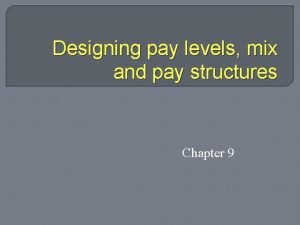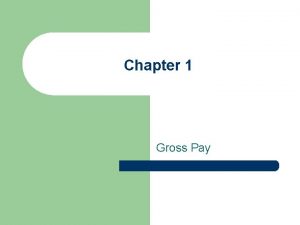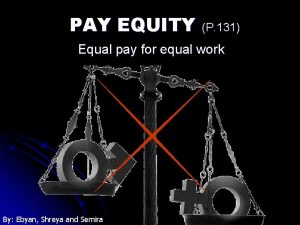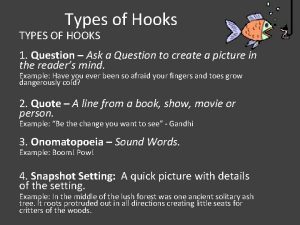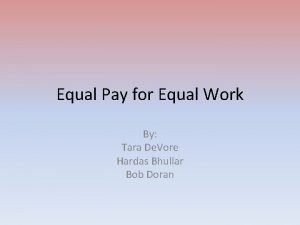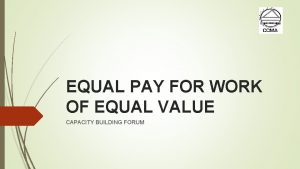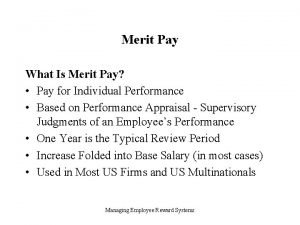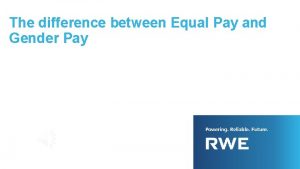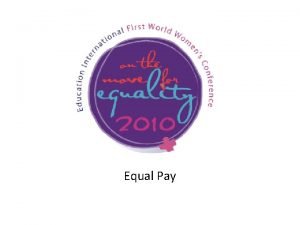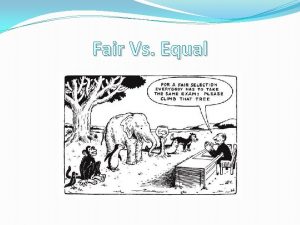Equal Work for Equal Pay Mary Hooks MD





































- Slides: 37

Equal Work for Equal Pay Mary Hooks, MD Vanderbilt University Danielle S. Walsh, MD East Carolina University United States of America COMMUNICATION AND NEGOTIATING SKILLS FOR LEADERSHIP IN WOMEN

Pay Equity WARNING: What you are about to see may make you very angry Hopefully just enough to do something and not enough to make you want to give up…

Stating the Problem: Two Key Issues � The Pay Gap �Equal pay for equal work – Not yet � The Leadership Dilemma �Some attribute the pay gap to differences in positions of authority or leadership � BOTH are problems

Related Global & Domestic Issues Health and survival: 96% of gap closed Education attainment: As above Political empowerment: Very large gap Child care Distribution of labor at home

Global Gender Gap Index 2010 Top 20 Four pillars: Economic participation & opportunity; Educational attainment; Health & survival; Political empowerment � � � � � Iceland: Finland: Norway: Sweden: Ireland: New Zealand: Denmark: Philippines: Nicaragua: Switzerland: 0. 86 0. 85 0. 84 0. 78 0. 77 � � � � � Netherlands: Belgium: Germany: Lesotho: Latvia: S. Africa: Luxembourg: UK: Cuba: Austria: **Canada # 21; US #22 0. 77 0. 76 0. 75 0. 74

Trends & Outliers The Bottom Ten: Overall Mali Morocco Cote d’Ivoire Saudi Arabia Syria Chad Pakistan Yemen 0. 58 0. 57 0. 56 0. 54 0. 50 Economic Participation 0. 57 0. 41 0. 55 0. 34 0. 27 0. 68 0. 31 0. 34

Trends & Outliers � “Top Ten”: �Four Nordic countries have consistently held the top positions �Iceland, Finland, Norway & Sweden � From 2006 -2012 �Gap decreasing in 88% �Gap INCREASING in 12%

Consistent Patterns of “Narrow Gap” Countries High literacy High labor force participation Low salary gaps Opportunities for leadership More shared participation in childcare More equitable distribution of labor at home Mandatory maternal AND paternal leave

Organization of Economic Cooperation & Development Special Report: Women and Work, Economist, Nov. 26, 2011

Special Report: Women and Work, Economist, Nov. 26, 2011

Leadership Gap Special Report: Women and Work, Economist, Nov. 26, 2011

Equal Pay for Equal Work In U. S. : Women are still paid only 0. 75 -0. 80/$1 of male colleagues Minority women: ○ African American: 0. 64 -0. 71/$1 ○ Latina: 0. 55 -0. 62/$1

Average monthly salaries in medicine for men and women UK Surgery Finland MD Thailand MD US Surgery Male £ 7686 5, 107 e 41, 358 b $290, 000 Female £ 6123 4347 e 25, 130 b $225, 000 Pay Gap 20% 15% 39% 22% Repeatedly, differences persist even when correcting for hours work, years of experience, and specialty choice. World. Salaries. org, Medscape. com

Academic Medicine: Faculty Rank & Per Cent Women Surgery Instructor Assistant Professor Associate Professor Full Professor Total 43% 25% 17% 9% 21% of all surgery faculty are women AAMC 2012

AAMC 2012

Factors Attributed to Differences Family responsibilities Fewer hours worked/part-time status Specialty selection based on family Geographical limitations due to family Hostile work cultures Failure to negotiate compensation Connally & Holdcraft 2009

What To Do � We could all stay in Finland or another Nordic country � Go home and work to close the gap � Holding institutions and governments responsible for reviewing salaries and closing the gaps by policy � Childcare programs, Maternity AND Paternity leave

What To Do Build programs that support women’s career success Individually, institutionally, and professionally Negotiate for the Opportunities/Positions Pay Resources Support & Information Negotiate at home

It Starts with You… � Did you negotiate when you took your current job, or were you just grateful/excited to get it? � Did you take the salary/benefits as offered or negotiate for something higher?

Her Place at the Table Ruling out differences in age, education level, and work experience, men use negotiation to promote their own interests far more often than women do. Left unchecked, disparities in negotiation quickly transform into pay and promotion inequalities Kolb. Et al, 2010

Why don’t we ask? We are “trained” not to from an early age Taught to be “communal, ” make relationships a priority, and focus on the needs of others, not themselves. Chores - babysitting Toys - baby dolls and play kitchens Avoid conflict – keep fair/even Mimic behavior of older children and adults

These internalized traits lead us to Put needs of others above advancing career Fail to recognize opportunities for advancement Perceive negotiation as “conflict” – something to be avoided and producing anxiety. Trained to placate rather than antagonize Prize interpersonal peace over personal gain

Not just the money Man negotiates for a high priority project in the organization. Direct contact with leaders and key personnel Advantage to him next time a project or promotion comes around Over time, the gap in advancement grows

In the employer’s best interest… Woman fails to advance - doesn’t ask Job is no longer challenging/satisfying She leaves Cost of replacement is significant – 150% of annual pay for professionals It is in the company’s best interest to develop and promote women

Ideal Worker � Person willing to put work before all else �Ability to manage crisis � Time to spend at work is unlimited �Unbounded meeting times and places � Demands of family, community, and personal life are secondary or at least rendered invisible in the workplace 1990 – Joan Acker

Two Generations of Discrimination First Generation � Clear-cut acts of bias � Blatant discrimination � Fewer resources � Harassment Second Generation � Workplace culture � Promotion policies � Lack of networks/mentors � Hyper-scrutiny

How Can I Do It? � Assume that everything about your working life is negotiable. -Salary -Schedules -Support staff -Responsibilities � Point out to the supervisor that your success will be their success �Know in advance what motivates the boss, where his/her needs are, and how you can help ensure you benefit each other

Choosing Projects Wisely � Interest you � Important to the department � In line with your professional goals � Avoid “invisible” work – lots of effort, little credit �Chief of Staff, 2 nd in command �Represent diversity on a committee �Counseling too many students/junior faculty �Fixing problems for others before they happen

Choosing Projects - Watch For � Appointments at a time of decline or problems � “Interim or Acting” – might not get credit or compensation � If say no, risk damaging political capital. � Solution – negotiate the role – define it, how rewarded, how assessed, duration, and what follows from it

Inherent Bias � Entrepreneur applying for a job position � Evaluate style, likability and competence � Same resume - ½ “Heidi” and ½ “Howard” � Howard – genuine, likable, and more likely to be hired � Heidi - self-promoting, power hungry, and aggressive

Backlash Too aggressive – disliked, ostracized, and unable to get what they want anyway. � Women who negotiated for more salary were viewed more negatively than men who did the same. � When women are seen as competent leaders, they are not liked; when they are liked, they are not respected. � How do you avoid this? Heilman M, et al. Penalties for Success, 2004.

Avoidance is not the answer… � Think not only of how you look when you negotiate (aggressive), but how you look when you do not negotiate (passive). � Think of negotiation as a conversation leading to agreement!

Make It about collaboration Appreciate the other side’s interests Joint problem solving Influence rather than coerce or demand Bring data when possible Use positive terms Say it with a smile!

Make it About the Institution Identifying pressing concerns or needs Lobby for responsibility to fix them Negotiate the time, resources, and support to succeed Turn “small wins” in to positive attention Make it about the good of the organization

The End Goal “At a completely fundamental level, power is the ability to change what it is people should even be thinking about or asking for. That is a level at which, if women actually attain power, then these struggles of getting an extra $10, 000 in salary are going to be obsolete. ”

JUST DO IT! Do it for yourself – because you deserve it Do it for future generations The more we accomplish now, the easier it will be for them Do it for your BOTH daughters & sons

Useful References “Special Report: Women & Work Closing the Gap ”, Economist; Nov. 26, 2011 or http: //www. economist. com/node/21539928 � AFL-CIO Dept. of Professional Employees, Fact Sheet 2010, Professional Women Vital Statistics, http: //www. pay-equity. org/PDFs/Prof. Women. pdf � Global Gender Gap Index � �http: //www 3. weforum. org/docs/WEF_Gender. Gap_Rep ort_2012. pdf � AAMC Data Book Tables, https: //www. aamc. org/databook/tables/
 I work all night i work all day to pay the bills
I work all night i work all day to pay the bills How much does wanda earn per hour
How much does wanda earn per hour Pay level and pay mix
Pay level and pay mix Merit pay vs incentive pay
Merit pay vs incentive pay 1-3 commission worksheet answers
1-3 commission worksheet answers Mass equal pay act
Mass equal pay act Equal pay act 1963 summary
Equal pay act 1963 summary [email protected]
[email protected] Mary wollstonecraft mary a fiction
Mary wollstonecraft mary a fiction Equal height equal light
Equal height equal light Taku graphics
Taku graphics Equal sharing and equal grouping is called
Equal sharing and equal grouping is called Opposite angle
Opposite angle Equal area vs equal angle stereonet
Equal area vs equal angle stereonet How do pay grades work
How do pay grades work Kenexa refinery
Kenexa refinery What should be given attention in this style
What should be given attention in this style Kontinuitetshantering
Kontinuitetshantering Typiska drag för en novell
Typiska drag för en novell Nationell inriktning för artificiell intelligens
Nationell inriktning för artificiell intelligens Vad står k.r.å.k.a.n för
Vad står k.r.å.k.a.n för Varför kallas perioden 1918-1939 för mellankrigstiden?
Varför kallas perioden 1918-1939 för mellankrigstiden? En lathund för arbete med kontinuitetshantering
En lathund för arbete med kontinuitetshantering Underlag för särskild löneskatt på pensionskostnader
Underlag för särskild löneskatt på pensionskostnader Tidböcker
Tidböcker Sura för anatom
Sura för anatom Förklara densitet för barn
Förklara densitet för barn Datorkunskap för nybörjare
Datorkunskap för nybörjare Tack för att ni lyssnade bild
Tack för att ni lyssnade bild Tes debattartikel
Tes debattartikel Magnetsjukhus
Magnetsjukhus Nyckelkompetenser för livslångt lärande
Nyckelkompetenser för livslångt lärande Påbyggnader för flakfordon
Påbyggnader för flakfordon Vätsketryck formel
Vätsketryck formel Svenskt ramverk för digital samverkan
Svenskt ramverk för digital samverkan Lyckans minut erik lindorm analys
Lyckans minut erik lindorm analys Presentera för publik crossboss
Presentera för publik crossboss Jiddisch
Jiddisch


